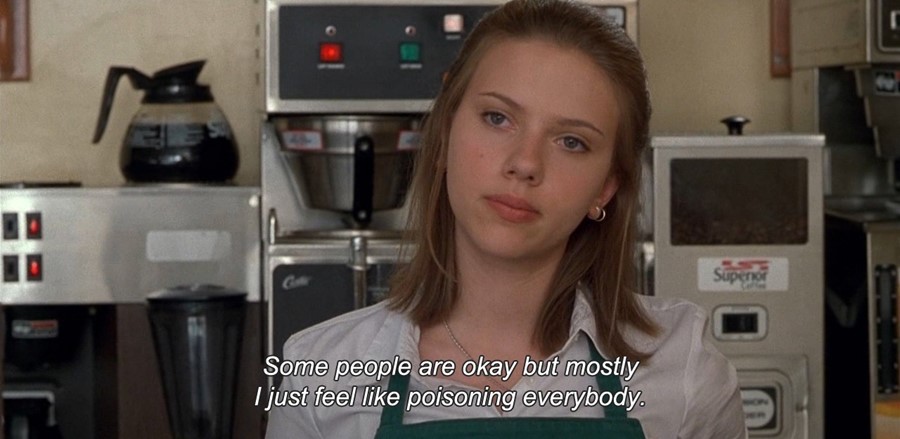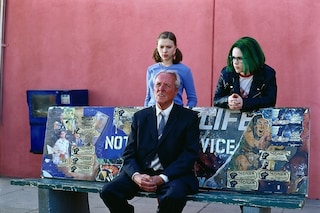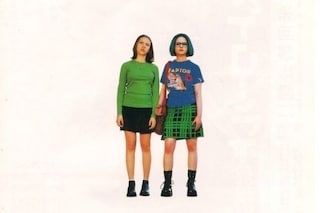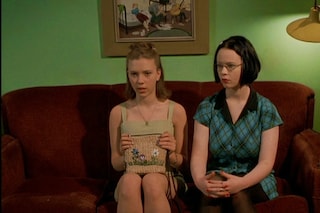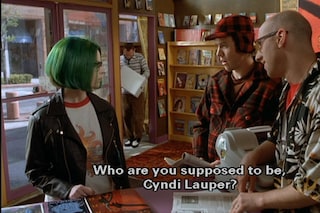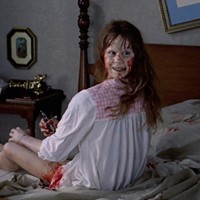Steve Buscemi’s music-collecting character, Seymour, was created so that Terry Zwigoff could use his favourite music in the film
Terry Zwigoff’s Ghost World (2001) remains the toll charge for entry into the world of films about disillusioned teens. Enid and Rebecca, the film’s two leads, are unapologetically pessimistic. Or are they realists? Unconcerned about the dismal prospects most post-graduates face, they bounce around the dog days of summer working a day job (Rebecca), befriending middle-aged men (Enid) and making fun of everyone who crosses their path (“Funky!”).
Years later, in the late 00s, a certain aesthetic blossomed online that pulled entire ways of life out of Ghost World, mixed in with the “I hate everybody” attitudes plucked from TV shows like MTV’s Daria and movies like Gregg Araki’s The Doom Generation (1995) and Todd Solondz’s Welcome to the Dollhouse (1995). They could all have easily been bundled for a “frequently bought together” package deal on Amazon. A starter kit for the angsty outsider. Whether or not it informed the entire Tumblr sad teen persona of preferring an XL pizza to a party with friends is open to debate. The film’s director, Terry Zwigoff, can’t exactly say. “I don't interact with teens too often, so have to profess ignorance here,” he told me of the film’s relation to today’s youngsters.
Yet, it remains a sort of clarion call for outsiders who can’t articulate their teenage angst in any truer way than this film already does. It’s perfect. Zwigoff adapted the film from Daniel Clowes’ graphic novel of the same name. Though it didn’t exactly cause a ruckus at the box office upon its release in 2001, the cult following Ghost World has built up continues to be the jewel in Zwigoff’s crown. He’s not haunted by its success. “Not at all,” he says. “I’m happy people like it so much and it hasn’t been forgotten.”
Ahead of his retrospective at New York’s Metrograph this weekend, Zwigoff reflects on his career-defining film that influenced a generation.
IT WAS CHANCE THAT THE FILM OPENS WITH A POPULAR BOLLYWOOD MOVIE, GUMNAAM (1965)
As the camera slowly tracks from one suburban window to the next in the opening credits of Terry Zwigoff’s Ghost World (2001), past the normies sitting on their couches, zombie’d out, we meet our first weirdo heroine: Enid. She shimmies along to an obscure dance sequence from 1965 Bollywood film, Gumnaam. The song is called “Jaan Pehechan Ho”, sung by Bollywood legend Mohammed Rafi. It’s an enticing way to introduce just how different this alterna-girl is from the rest of society. As everyone passively watches their TV sets, Enid frantically dances along to a charged Hindi flick. It was a pointed choice to include for Zwigoff. “I saw a short clip of it on a VHS tape and I really loved it and decided I needed to use it in Ghost World somehow,” Zwigoff recalls. “Wasn’t too logical an idea, but I knew I had to do it.” While it was a chance encounter with the VHS tape that led the director to include it, Zwigoff admits his knowledge of the Bollywood scene doesn’t run very deep. “I confess to being woefully ignorant about Bollywood, but trying to educate myself.”
ZWIGOFF CREATED SEYMOUR’S CHARACTER SO HE COULD USE HIS OWN RECORD COLLECTION
When pitching the film to Hollywood studio executives, they had a much different film in mind. “‘Oh, so what’s this film about, teenage girls? Oh that’s good, we can do a great pop soundtrack’,” Zwigoff recalled of his meetings to Filmmaker. The music swerved left from the pop music du jour that executives were expecting, instead opting for a soundtrack featuring greats like “C-h-i-c-k-e-n Spells Chicken” by McGee Bros, and “Bye Bye Baby Blues” by Little Hat Jones. “I used all late 1920s and early 30s music from my own 78 record collection,” Zwigoff says. It was all music that Seymour, who is a music collector in the film, would listen to. Hence that character’s creation. “I think the studio wanted more of a contemporary pop music soundtrack, you know, for teenage girls and all. But, eventually, they deemed the finished film so uncommercial that they let me do what I wanted. A minor miracle. In my mind this is the only way the film would have worked.”
ONE THEORY GOES THAT THE ENDING SCENE IS A METAPHOR FOR SUICIDE
Many diehards posited that the ending of the film, when Enid boards a bus on its way to somewhere in particular, was actually a metaphor for her committing suicide. You can check them out on messageboards across the web, posted by people with usernames like ‘Wetbones’. Is it true, though? In an interview with Dazed last year, graphic novelist Daniel Clowes addressed them, saying, “It certainly never dawned on me, but maybe on some unconscious level that’s what I was thinking. I don’t know. I wouldn’t want to shoot down any theory necessarily, but I was somewhat shocked when that became the opinion of more than just a few people. It becomes sort of accepted as one of the answers for that. I thought it was much more of a hopeful ending.” Zwigoff agrees, saying, “I wanted it to be ambiguous, but my own feeling about it was that Enid was moving on with her life,” says Zwigoff.
Terry Zwigoff’s retrospective is on at Metrograph NYC from May 19-21
